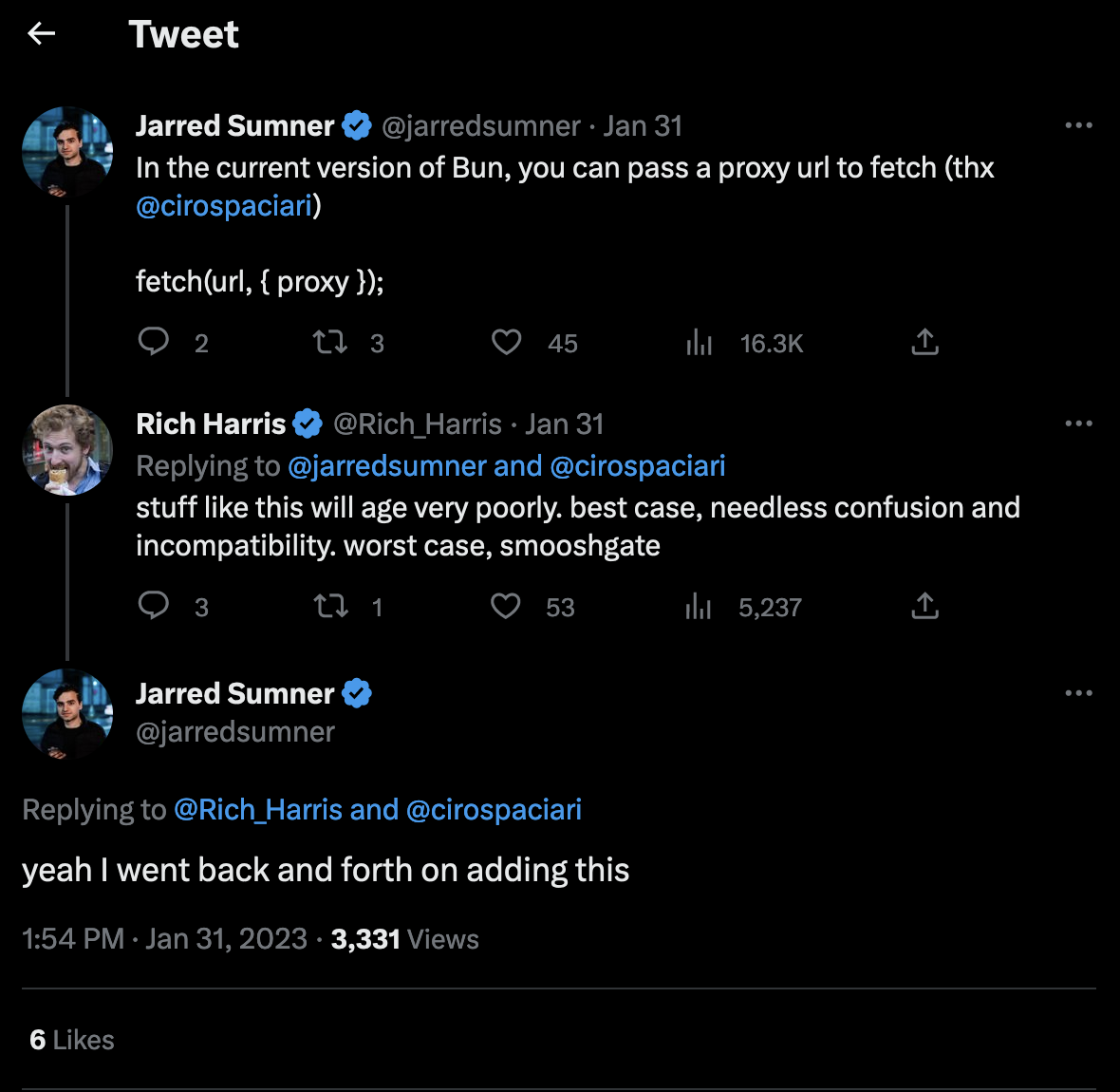Don't Break The Web
Don’t Break The Web
As a web developer, I like to follow prominent people working in the web on twitter. It was there that I came across this exchange between Rich Harris, the creator of the web framework Svelte, and Jarred Sumner, the creator of the new javascript runtime Bun.

Smooshgate?
As much as I think people should have their own website, this exchange does highlight some of what’s great about social media. Getting to see two experts have an open discussion and technical debate in public view, is worth praising.
The details of what they’re discussing doesn’t matter. What really piqued my interest was the mention of ‘Smooshgate’. I wondered what is smooshgate? It obviously isn’t good, but it sounds like some sort of tasty, supermarket, own-brand milkshake.
So, naturally, I googled it, and the first thing that popped up was a page on the Chrome developers site, titled “SmooshGate FAQ”. Ah! Exactly what I was looking for!
The FAQ is worth reading for yourself, but I’ll just give a very quick overview of Smooshgate. Back in the day, there was a popular javascript library called MooTools. This
provided developers with a useful array method called .flatten(). However, they used a wonky implementation, so that in 2018, when browsers shipped a new, native javascript
method called .flatten(), it broke old websites that used MooTools. This caused a bit of panic, but the browsers decided to rename their method. People jokingly suggested
.smoosh() as the replacement, hence the name Smooshgate, but they ended up going with .flat().
What they make clear in the FAQ, is that the browsers had to rename it, because otherwise old websites that were working, would now be broken. A key design principle among the people who decide these things, is “Don’t Break The Web”. An old website should not stop working because of a feature added for new websites. This is, I think, a good decision.
An example they use, is that of the promotional website for the 1996 film Space Jam. Someone created this website over 25 years ago, and it’s still up today. That is a good thing. Things shouldn’t just break because developers wanted a shiny new javascript feature.
I wanted to write this post, as a sort of homage to the idea of “Don’t Break The Web”, and to some of my favourite websites. Not ones I use often, or really at all. But websites that just make me happy that they exist, and that, somehow, still work.
Fishing for Web Traffic
I have a friend who loves fishing, and one day he showed me the website for the, now defunct, South Western Regional Fisheries Board. Please take some time to enjoy this website. The design, the colour palette, the comic sans font, the microsoft paint drawn images, and of course the amazing fish animations.

Smells Fishy
Of course, a website for an organisation that no longer exists raises some questions. Who? Why? How? More specifically, what server was still serving this page, all these years later? After looking through some of the pages, the Angling News tells us that this site dates back to January 2003, not long after Ireland switched to the euro, which explains why some pages use both euro and punt.
The answer to my question is in the url, http://homepage.eircom.net/~swrfb/. Eircom was of course, the national, public telecoms company of Ireland back in those days. My
guess is that customers were allowed to create their own homepage, with each of them using homepage.eircom.net as the base domain, and the final part, eg. ~swrfb,
identifying individual homepages, especially as ~ is often used to represent a home directory in computer settings. Eircom was later privatised and renamed Eir, the
base url itself, and http://homepage.eircom.net, eventually redirects to https://www.eir.ie.
This did raise some more questions, if ~swrfb is still a working website, what others are out there? So I took it upon myself to try random words and letters in the hope of
stumbling upon some more. The ones I managed to find are,
- http://homepage.eircom.net/~weather/, which seems to have been made by a primary school in Finglas, and has a nice quiz,
- http://homepage.eircom.net/~women/ which is s a women’s organisation from Mayo, and features a picture with the now somewhat infamous, former politician Padraig Flynn.
- http://homepage.eircom.net/~cpi/ which shows how technologically advanced Irish communists can be.
- And lastly, http://homepage.eircom.net/~gaa/ is a test page, that gives some insight into the technical capabilities of the other pages, such as the fact that they were limited to 20 Mb.
These aren’t the only old web pages out there, and efforts like web archive do admirable work to keep broken websites accessible, but nothing beats a webpage still functioning 20 years after it’s been forgotten by the people that made it. If you find any other old websites, let me know, and remember, Don’t Break The Web.